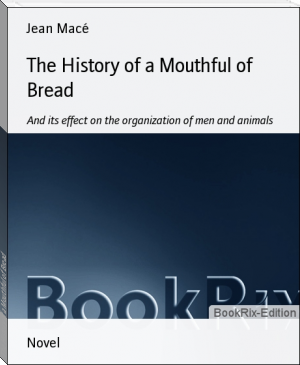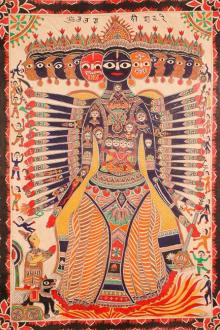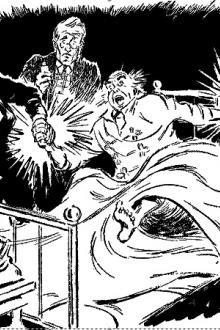The History of a Mouthful of Bread, Jean Macé [best autobiographies to read TXT] 📗

- Author: Jean Macé
Book online «The History of a Mouthful of Bread, Jean Macé [best autobiographies to read TXT] 📗». Author Jean Macé
will give you a piece of advice which will perhaps make some people stare. Ask your papa to lend you Michelet's book, The Sea , and look there for what is said about the mysterious animals which lie hid beneath the waves. His book was not written for you as this one is: and if, in spite of all my good intentions, I have not always succeeded in being as comprehensible as I meant to be, Michelet, who never thought about little people when he took up his pen, will certainly startle you now and then. But do not be disheartened by a word. You will find there, that which will be forever plain to you, the poesy of nature, and children comprehend that better than learned men.
LETTER XL.
THE NOURISHMENT OF PLANTS.
One more word before we part about the last of the eaters, about Vegetables. They will furnish you with a new and very clearly marked proof of the uniformity of the fundamental conditions to which the Author of life has subjected all organised beings.
Let us look once more at this oak, of whose manner of growth I was obliged to give you a sketch beforehand, in order to show you the ties which unite it with its immediate neighbors in the animal kingdom. How does it feed? I need not tell you this. It feeds by its roots, which suck up in the bosom of the earth the water charged with the juices which form its nourishment. Are you aware that every large branch had its subterranean fellow or representative, and that the annual shoot at the top of the tree is reproduced at the base by fresh fibres, which extend themselves in the soil of the earth, in proportion as their sisters above make their way in the air? And thus, by means of organs ever young, the life and progress of the great association is kept up, while those members whose day of work is over still remain there as the supports of the edifice. It is the same with human societies. They are sustained by what is old, but they live and progress only by what is young. The sap, then, which is the name given to the moisture or water sucked in by the young roots, having once got into the cells of which the tissue of the fibres is composed, passes from one to another, and travels thus to the top of the tree, where it is wanted by the leaves.
There is no obvious machinery here, however, to impel it forward. It journeys on of itself, as it were, under the action of laws which have never been satisfactorily explained, but all of which are dependent on the vital force or life-power of the tree, inasmuch as without it there is no circulation. One agent, but by no means the principal, or it would act as well in a dead tree as a living one, is capillary attraction ; and, if you wish to know what that is, you have only to think of what happens to a towel, if you hang it upon a peg, and leave the end of it soaking in water. Does not the "wet" seem to climb up it thread by thread, till it is damp from one end to the other? A little in this way-but these similes are very imperfect, and will not bear close application-the sap rises in a tree, stealing up branch by branch; and it is then called ascending sap . [Footnote: M. Macé speaks of this sap as the blood of the tree , and of the leaves only as
lungs . These statements have been modified so as to meet the fact that
ascending sap consists of, and conveys the raw elements of food to, the leaves; that in the leaves this food is digested , as well as brought in contact with the air, and that it is thus converted into that nourishing fluid, the descending sap , which certainly plays the part of steward to the tree as our blood does to us, and therefore may now be called the blood of the tree. It must be remembered, however, that each tree has its own sort of steward, as the case of the Euphorbia (quoted afterwards) plainly shows. The analogy with the more general substance of blood is therefore not very complete.-TR.]
It arrives at last at the leaves, which it enters as our food enters our stomachs, and for the same purpose; for in them takes place, as in all true stomachs, that process of digestion by which the elements of the crude sap-food are decomposed from their first condition, and converted into a nourishing chyle; in each tree of a sort "after its kind."
But more than this. Like the outer coat of the earthworm, the coat of the leaf affords a passage to air and moisture through its surface; and here, therefore, takes place that mysterious exchange which is everywhere the essential condition of life. Here is the charcoal-market as before, only the bargainers have changed parts. The air, which in the other case received the carbon, delivers it up, now, and receives oxygen in exchange; exactly the reverse of its traffic with animals. In other words, the tree inhales through its leaves the carbonic acid gas thrown into the atmosphere by our lungs. On its own responsibility it breaks through the alliance between the carbon and oxygen contracted in our organs; keeps the carbon for its own use, to restore it to us another day under the form of wood, or, by the aid of the charcoal-burner, in the pure and simple state of charcoal; and sets at liberty the oxygen, which once more goes off in search of new lungs and a fresh alliance. Thus a constant equilibrium is maintained in the atmosphere; and thus, by a system of perpetual rotation or everlasting merry-go-round, the same substances serve, indefinitely, to support life of every opposite description.
Now there are two things to be remembered in this inverted respiration of vegetables. In the first place, it occurs only in the parts which are green . Flowers, fruit, the root, and every part of any other color, do as we do when we breathe; i.e. deprive the air of its oxygen, charging it with carbonic acid instead. For which reason, by-the-by, we ought not to keep flowers in a bedroom at night. Charming as they are, they are poisoners , and a headache is what we may fairly expect after sleeping shut in with them in the same room. It is almost as bad to allow green boughs to remain there either, for, in the dark, even the green parts cease to purify the air, and begin like the others to manufacture carbonic acid, at the expense of course of their carbon, which thus by degrees is used up. Now, as it is the carbon which constitutes the solid fibres of plants and produces their green color, they soon become yellow and limp when deprived of light. You may, perhaps, have wondered why the gardener amused himself with smothering his poor lettuces by tying them up at top like a knot of "back hair," instead of letting them grow freely in the air and sunshine. It is, my dear, to make them more tender and delicate for you to eat; and those beautiful, crisp, yellow leaves, so delicious to the tooth, would have been green and tough, had they not slowly and quietly let out a great portion of their store of carbon in darkness during the last few days, before being gathered. Even without playing the gardener, you may assure yourself of this fact in a still more simple manner. Put a flat board upon the lawn and leave it there for three days; then take it up again, and you will find just where the board has prevented the light from reaching the grass, a yellow mark so distinctly traced as to be seen from the other end of the garden.
But to return to the sap, which we left undergoing a change from air and solar influences in the leaves. The ascending sap was to all appearance only clear water. When it returns from the leaves, charged with carbon, it is a thick juice having almost the consistency, and sometimes even the color of milk, and is possessed of properties altogether new. The most striking example that I can give you of thedifference of the two states of sap is the Euphorbia of the Canary Islands, whose digestive or descending sap is a violent poison. When the natives of the country are accidentally pressed by thirst, they carefully remove the bark in which the fatal juice circulates, and are then able to refresh themselves safely by sucking the stem, which yields only the watery sap sucked from the ground, and as yet unaltered and harmless.
Each of these two saps, in fact, has its path distinctly traced for it: the first rises through the wood, the second descends through the bark, whence it is called descending sap. If you wish to satisfy yourself of this, fasten a rather tight knot of pack-thread round a young branch, and after a time you will see it pine below the knot and become swollen above it, an unanswerable proof that the nutritive juices flowed downward through the bark; for the wood inside the branch will have been uninjured by the strangling pressure. Remember this, my dear, when you are playing in the garden, and do not injure the bark of the young trees your father likes so much to see flourishing. It is by the bark that they are nourished, and you might even kill them by treating it too roughly.
And now I must show you how the nutrition is carried on, or, if you like better, how the tree grows by means of this descending sap. See: here is a fir tree, which has just been cut down to the ground. Now, if you like, I will tell you in a moment how old it is. I will even tell you the age of every branch, little and big ones both, without making a mistake in a single year; and you know as well as I do that I am no conjuror. You see these small circles so delicately drawn, as it were, upon the face of the sawn trunk, each wider than the last, as if they were composed of a set of tubes, of unequal sizes, fitting exactly into each other. Now count them; and you will perhaps find twenty-five; and as each of these circles represents the work of one year, you will know that the tree is twenty-five years old. In spring, when the sap begins to move more briskly, it deposits everywhere between the wood and the bark, from the trunk to the farthest boughs of the tree, a uniform layer of a thick liquid, which moulds itself exactly upon the wood already formed. This layer stiffens during the year; it gets filled with the carbon left in it atom after atom, by each drop of the descending sap as it goes by, and thus insensibly becoming organised and hardened. When winter arrives to interrupt the work, it will have formed two ligneous, i.e. woody layers, as they are called. Of these, one belongs to the wood, and will never move again so long as the tree lasts, for it will be covered over, and as it were buried, by the successive layers yet to come; while, on the contrary, the other (layer) belongs to the bark, and is doomed to find itself perpetually forced outwards by the fresh layers, which will
LETTER XL.
THE NOURISHMENT OF PLANTS.
One more word before we part about the last of the eaters, about Vegetables. They will furnish you with a new and very clearly marked proof of the uniformity of the fundamental conditions to which the Author of life has subjected all organised beings.
Let us look once more at this oak, of whose manner of growth I was obliged to give you a sketch beforehand, in order to show you the ties which unite it with its immediate neighbors in the animal kingdom. How does it feed? I need not tell you this. It feeds by its roots, which suck up in the bosom of the earth the water charged with the juices which form its nourishment. Are you aware that every large branch had its subterranean fellow or representative, and that the annual shoot at the top of the tree is reproduced at the base by fresh fibres, which extend themselves in the soil of the earth, in proportion as their sisters above make their way in the air? And thus, by means of organs ever young, the life and progress of the great association is kept up, while those members whose day of work is over still remain there as the supports of the edifice. It is the same with human societies. They are sustained by what is old, but they live and progress only by what is young. The sap, then, which is the name given to the moisture or water sucked in by the young roots, having once got into the cells of which the tissue of the fibres is composed, passes from one to another, and travels thus to the top of the tree, where it is wanted by the leaves.
There is no obvious machinery here, however, to impel it forward. It journeys on of itself, as it were, under the action of laws which have never been satisfactorily explained, but all of which are dependent on the vital force or life-power of the tree, inasmuch as without it there is no circulation. One agent, but by no means the principal, or it would act as well in a dead tree as a living one, is capillary attraction ; and, if you wish to know what that is, you have only to think of what happens to a towel, if you hang it upon a peg, and leave the end of it soaking in water. Does not the "wet" seem to climb up it thread by thread, till it is damp from one end to the other? A little in this way-but these similes are very imperfect, and will not bear close application-the sap rises in a tree, stealing up branch by branch; and it is then called ascending sap . [Footnote: M. Macé speaks of this sap as the blood of the tree , and of the leaves only as
lungs . These statements have been modified so as to meet the fact that
ascending sap consists of, and conveys the raw elements of food to, the leaves; that in the leaves this food is digested , as well as brought in contact with the air, and that it is thus converted into that nourishing fluid, the descending sap , which certainly plays the part of steward to the tree as our blood does to us, and therefore may now be called the blood of the tree. It must be remembered, however, that each tree has its own sort of steward, as the case of the Euphorbia (quoted afterwards) plainly shows. The analogy with the more general substance of blood is therefore not very complete.-TR.]
It arrives at last at the leaves, which it enters as our food enters our stomachs, and for the same purpose; for in them takes place, as in all true stomachs, that process of digestion by which the elements of the crude sap-food are decomposed from their first condition, and converted into a nourishing chyle; in each tree of a sort "after its kind."
But more than this. Like the outer coat of the earthworm, the coat of the leaf affords a passage to air and moisture through its surface; and here, therefore, takes place that mysterious exchange which is everywhere the essential condition of life. Here is the charcoal-market as before, only the bargainers have changed parts. The air, which in the other case received the carbon, delivers it up, now, and receives oxygen in exchange; exactly the reverse of its traffic with animals. In other words, the tree inhales through its leaves the carbonic acid gas thrown into the atmosphere by our lungs. On its own responsibility it breaks through the alliance between the carbon and oxygen contracted in our organs; keeps the carbon for its own use, to restore it to us another day under the form of wood, or, by the aid of the charcoal-burner, in the pure and simple state of charcoal; and sets at liberty the oxygen, which once more goes off in search of new lungs and a fresh alliance. Thus a constant equilibrium is maintained in the atmosphere; and thus, by a system of perpetual rotation or everlasting merry-go-round, the same substances serve, indefinitely, to support life of every opposite description.
Now there are two things to be remembered in this inverted respiration of vegetables. In the first place, it occurs only in the parts which are green . Flowers, fruit, the root, and every part of any other color, do as we do when we breathe; i.e. deprive the air of its oxygen, charging it with carbonic acid instead. For which reason, by-the-by, we ought not to keep flowers in a bedroom at night. Charming as they are, they are poisoners , and a headache is what we may fairly expect after sleeping shut in with them in the same room. It is almost as bad to allow green boughs to remain there either, for, in the dark, even the green parts cease to purify the air, and begin like the others to manufacture carbonic acid, at the expense of course of their carbon, which thus by degrees is used up. Now, as it is the carbon which constitutes the solid fibres of plants and produces their green color, they soon become yellow and limp when deprived of light. You may, perhaps, have wondered why the gardener amused himself with smothering his poor lettuces by tying them up at top like a knot of "back hair," instead of letting them grow freely in the air and sunshine. It is, my dear, to make them more tender and delicate for you to eat; and those beautiful, crisp, yellow leaves, so delicious to the tooth, would have been green and tough, had they not slowly and quietly let out a great portion of their store of carbon in darkness during the last few days, before being gathered. Even without playing the gardener, you may assure yourself of this fact in a still more simple manner. Put a flat board upon the lawn and leave it there for three days; then take it up again, and you will find just where the board has prevented the light from reaching the grass, a yellow mark so distinctly traced as to be seen from the other end of the garden.
But to return to the sap, which we left undergoing a change from air and solar influences in the leaves. The ascending sap was to all appearance only clear water. When it returns from the leaves, charged with carbon, it is a thick juice having almost the consistency, and sometimes even the color of milk, and is possessed of properties altogether new. The most striking example that I can give you of thedifference of the two states of sap is the Euphorbia of the Canary Islands, whose digestive or descending sap is a violent poison. When the natives of the country are accidentally pressed by thirst, they carefully remove the bark in which the fatal juice circulates, and are then able to refresh themselves safely by sucking the stem, which yields only the watery sap sucked from the ground, and as yet unaltered and harmless.
Each of these two saps, in fact, has its path distinctly traced for it: the first rises through the wood, the second descends through the bark, whence it is called descending sap. If you wish to satisfy yourself of this, fasten a rather tight knot of pack-thread round a young branch, and after a time you will see it pine below the knot and become swollen above it, an unanswerable proof that the nutritive juices flowed downward through the bark; for the wood inside the branch will have been uninjured by the strangling pressure. Remember this, my dear, when you are playing in the garden, and do not injure the bark of the young trees your father likes so much to see flourishing. It is by the bark that they are nourished, and you might even kill them by treating it too roughly.
And now I must show you how the nutrition is carried on, or, if you like better, how the tree grows by means of this descending sap. See: here is a fir tree, which has just been cut down to the ground. Now, if you like, I will tell you in a moment how old it is. I will even tell you the age of every branch, little and big ones both, without making a mistake in a single year; and you know as well as I do that I am no conjuror. You see these small circles so delicately drawn, as it were, upon the face of the sawn trunk, each wider than the last, as if they were composed of a set of tubes, of unequal sizes, fitting exactly into each other. Now count them; and you will perhaps find twenty-five; and as each of these circles represents the work of one year, you will know that the tree is twenty-five years old. In spring, when the sap begins to move more briskly, it deposits everywhere between the wood and the bark, from the trunk to the farthest boughs of the tree, a uniform layer of a thick liquid, which moulds itself exactly upon the wood already formed. This layer stiffens during the year; it gets filled with the carbon left in it atom after atom, by each drop of the descending sap as it goes by, and thus insensibly becoming organised and hardened. When winter arrives to interrupt the work, it will have formed two ligneous, i.e. woody layers, as they are called. Of these, one belongs to the wood, and will never move again so long as the tree lasts, for it will be covered over, and as it were buried, by the successive layers yet to come; while, on the contrary, the other (layer) belongs to the bark, and is doomed to find itself perpetually forced outwards by the fresh layers, which will
Free e-book «The History of a Mouthful of Bread, Jean Macé [best autobiographies to read TXT] 📗» - read online now
Similar e-books:





Comments (0)